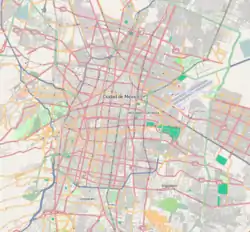Coyuya metro station
Coyuya is a station on the Mexico City Metro.[2][3]
| STC rapid transit | |||||||||||
 | |||||||||||
| General information | |||||||||||
| Coordinates | 19.398521°N 99.113545°W | ||||||||||
| Operated by | Sistema de Transporte Colectivo (STC) | ||||||||||
| Line(s) | |||||||||||
| Platforms | 1 island platform | ||||||||||
| Tracks | 2 | ||||||||||
| Connections | |||||||||||
| Construction | |||||||||||
| Structure type | At grade | ||||||||||
| Other information | |||||||||||
| Status | In service | ||||||||||
| History | |||||||||||
| Opened | 20 July 1994 | ||||||||||
| Passengers | |||||||||||
| 2022 | 7,735,951[1] | ||||||||||
| Rank | 38/195[1] | ||||||||||
| Services | |||||||||||
| |||||||||||
| Location | |||||||||||
 Location within Mexico City | |||||||||||
| Area map | |||||||||||
General information
Coyuya is on Line 8, between Metro Santa Anita and Metro Iztacalco.[2][3] It is located in the Iztacalco borough, in the eastern portion of the Mexican Federal District, and serves the Colonia Tlazintla district and neighbourhoods surrounding Avenida Coyuya, Avenida Francisco del Paso y Troncoso (eje 3-Ote), and Avenida Plutarco Elías Calles (eje 4-Sur).[2] A surface station, it was first opened to public passenger traffic on 20 July 1994.[4]
Ridership
| Annual passenger ridership | |||||
|---|---|---|---|---|---|
| Year | Ridership | Average daily | Rank | % change | Ref. |
| 2022 | 7,735,951 | 21,194 | 38/195 | +38.61% | [1] |
| 2021 | 5,581,291 | 15,291 | 39/195 | +11.67% | [5] |
| 2020 | 4,998,200 | 13,656 | 57/195 | −41.21% | [6] |
| 2019 | 8,501,595 | 23,292 | 61/195 | +2.68% | [7] |
| 2018 | 8,279,437 | 22,683 | 71/195 | +7.88% | [8] |
| 2017 | 7,674,640 | 21,026 | 81/195 | +0.83% | [9] |
| 2016 | 7,611,525 | 20,796 | 86/195 | +1.45% | [10] |
| 2015 | 7,502,640 | 20,555 | 85/195 | +3.23% | [11] |
| 2014 | 7,267,919 | 19,912 | 89/195 | −7.61% | [12] |
| 2013 | 7,866,281 | 21,551 | 85/195 | −2.54% | [13] |
| 2012 | 8,071,336 | 22,052 | 80/195 | −7.12% | [14] |
| 2011 | 8,690,390 | 23,809 | 77/175 | +19.92% | [15] |
| 2010 | 7,246,883 | 19,854 | 77/175 | – | [16] |
Name and iconography
The station logo depicts the ankle of an Aztec dancer festooned with a cuff-rattle made from nutshells – a pre-Hispanic musical instrument known by the Spanish name cascabel (similar to jingle bells).[2][3] "Coyuya" is a Nahuatl toponym that means "place where cascabeles are made".[2]
References
- "Afluencia de estación por línea 2022" [Station traffic per line 2022] (in Spanish). Sistema Transporte Colectivo Metro. 2023. Archived from the original on 5 March 2023. Retrieved 5 March 2023.
- "Coyuya" (in Spanish). Sistema de Transporte Colectivo. Archived from the original on 8 August 2011. Retrieved 20 August 2011.
- Archambault, Richard. "Coyuya » Mexico City Metro System". Retrieved 20 August 2011.
- Monroy, Marco. Schwandl, Robert (ed.). "Opening Dates for Mexico City's Subway". Retrieved 20 August 2011.
- "Afluencia de estación por línea 2021" [Station traffic per line 2021] (in Spanish). Sistema Transporte Colectivo Metro. 2020. Archived from the original on 7 March 2022. Retrieved 7 March 2022.
- "Afluencia de estación por línea 2020" [Station traffic per line 2020] (in Spanish). Sistema Transporte Colectivo Metro. 2021. Archived from the original on 21 June 2021. Retrieved 21 June 2021.
- "Afluencia de estación por línea 2019" [Station traffic per line 2019] (in Spanish). Sistema Transporte Colectivo Metro. 2020. Archived from the original on 8 April 2020. Retrieved 3 May 2020.
- "Afluencia de estación por línea 2018" [Station traffic per line 2018] (in Spanish). Sistema Transporte Colectivo Metro. 2019. Archived from the original on 6 June 2019. Retrieved 7 April 2020.
- "Afluencia de estación por línea 2017" [Station traffic per line 2017] (in Spanish). Sistema Transporte Colectivo Metro. 2019. Archived from the original on 3 May 2020. Retrieved 3 May 2020.
- "Afluencia de estación por línea 2016" [Station traffic per line 2016] (in Spanish). Sistema Transporte Colectivo Metro. 2017. Archived from the original on 3 May 2020. Retrieved 3 May 2020.
- "Afluencia de estación por línea 2015" [Station traffic per line 2015] (in Spanish). Sistema Transporte Colectivo Metro. 2016. Archived from the original on 3 May 2020. Retrieved 6 May 2020.
- "Afluencia de estación por línea 2014" [Station traffic per line 2014] (in Spanish). Sistema Transporte Colectivo Metro. 2015. Archived from the original on 3 May 2020. Retrieved 6 May 2020.
- "Afluencia de estación por línea 2013" [Station traffic per line 2013] (in Spanish). Sistema Transporte Colectivo Metro. 2014. Archived from the original on 3 May 2020. Retrieved 6 May 2020.
- "Afluencia de estación por línea 2012" [Station traffic per line 2012] (in Spanish). Sistema Transporte Colectivo Metro. 2013. Archived from the original on 3 May 2020. Retrieved 6 May 2020.
- "Afluencia de estación por línea 2011" [Station traffic per line 2011] (in Spanish). Sistema Transporte Colectivo Metro. 2012. Archived from the original on 7 May 2020. Retrieved 6 May 2020.
- "Afluencia de estación por línea 2010" [Station traffic per line 2010] (in Spanish). Sistema Transporte Colectivo Metro. 2011. Archived from the original on 7 May 2020. Retrieved 6 May 2020.